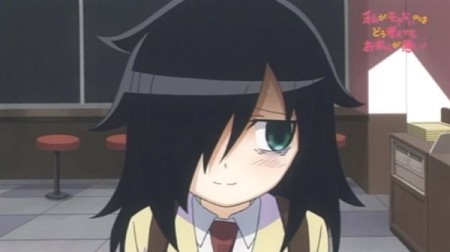Ask John: Is Watamote Social Commentary?

Question:
Does Watamote count as social commentary?
Answer:
The Watashi ga Motenai no wa dou Kangaetemo Omaera ga Warui! story is seemingly almost certainly more a reflection of creator Nico Tanigawa’s own high school experiences than a conscious examination of contemporary Japanese societal trends, but the fact that WataMote is primarily an otaku-oriented comedy doesn’t at all exclude it from also serving as viable social commentary. The contemporary Japanese psychological concept known as “chuunibyou” was initially coined by Japanese celebrity & critic Hikaru Ijuin in 1999. The idea of mental escapism, envisioning oneself to be part of another world first appeared in anime in 1966’s Mahou Tsukai Sally, which depicted a resident of a fantasy world coming to Earth, and branched into the concept of humans being transported to fantasy worlds in Aura Battler Dunbine & Super Dimension Century Orguss, both from 1983. An alternate form of chuunibyou known as “dokyun kei chuunibyou” appeared in 1990’s OVA franchises like 1996’s Chameleon and Kyo Kara Ore Wa that depicted teens who self-identified by pretending to be rambunctious juvenile delinquents. While these self-delusion tropes have been evident in anime for years, they’ve recently stepped forward with a new prominence with anime productions including WataMote, Chuunibyou Demo Koi ga Shitai!, Aku no Hana, and Aura: Maryuuinkouga Saigo no Tatakai.
While extreme self-delusion within literature certainly dates back to at least Miguel de Cervantes’s 1605 novel Don Quixote, the recent prominence of anime that specifically concentrate on the the tendency of Japanese youth to disassociate with reality or create false personae has to be accepted as a deliberate observation of an existing trend. Just as previous anime including Sayonara Zetsubou-sensei, Yamato Nadesico Shichihenge, and Rozen Maiden have focused attention on the hikikomori phenomenon, and anime including Hana Yori Dango, Oniisama E…, Narutaru, Shiranpuri, and Ijime have focused attention on the problem of bullying in Japanese schools, current shows like WataMote are (hopefully) provoking curiosity over exactly what’s motivating Japanese youth to disengage from everyday reality. Chuunibyou Demo Koi ga Shitai! and WataMote have taken a relatively lighthearted approach to the concept of willful psychological disassociation while Aku no Hana and Aura have dealt with the theme a bit more seriously, illustrating real-world causes and impacts of teen cognitive disassociation. Anime titles don’t need to provide solutions to or thorough reasons for the development of observed social trends; merely pointing them out, overtly commenting that they exist literally constitutes overt “social commentary.”

